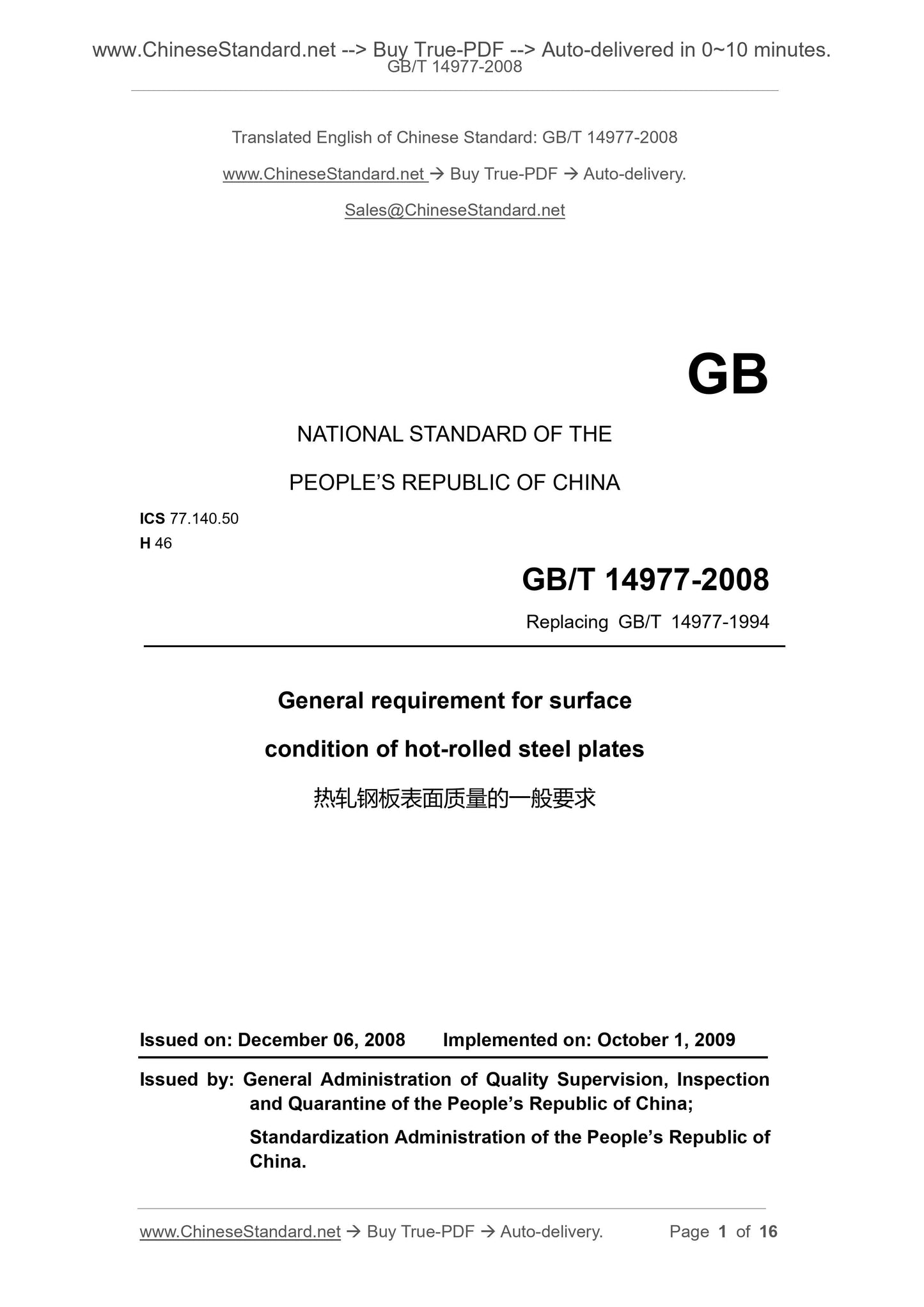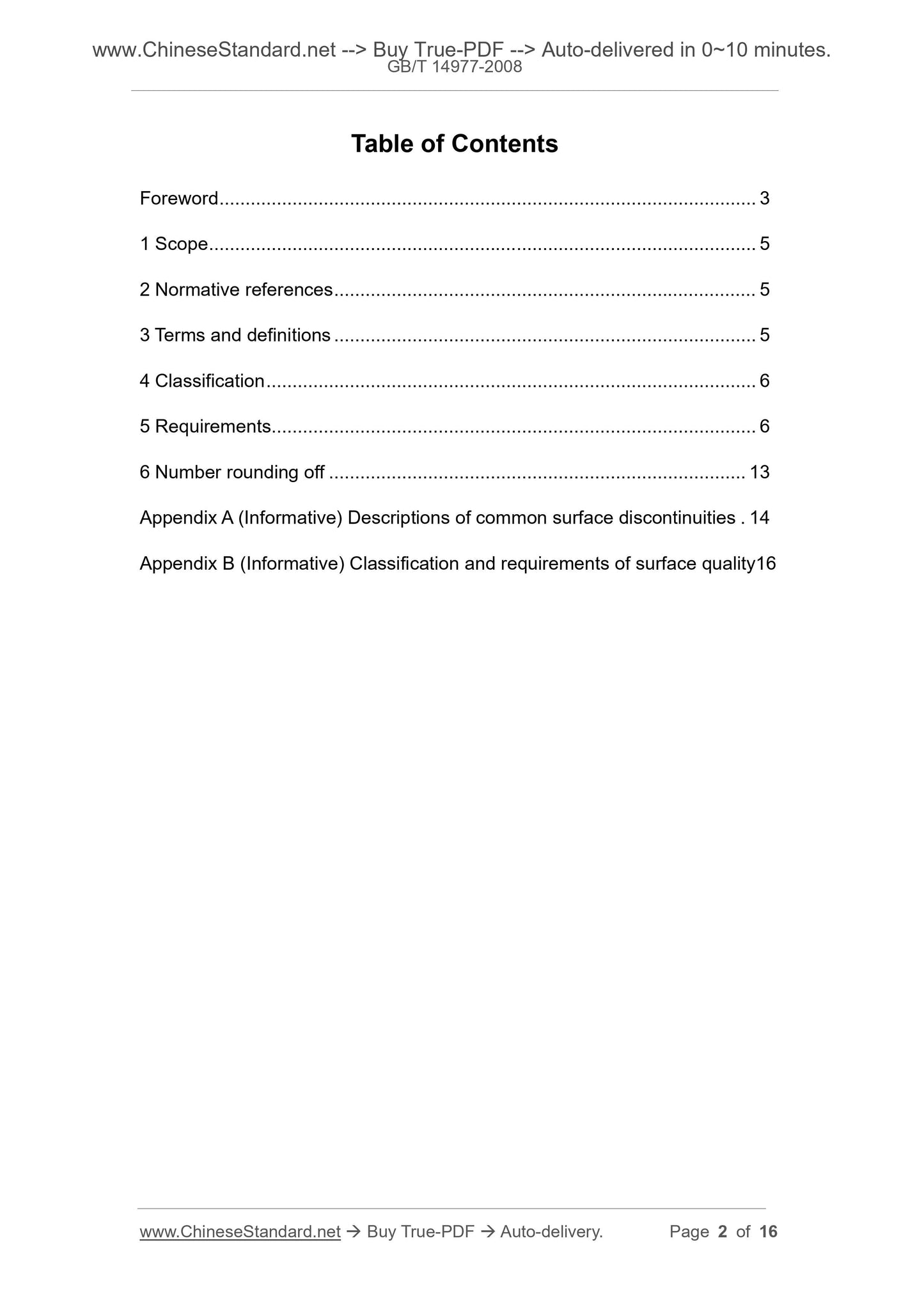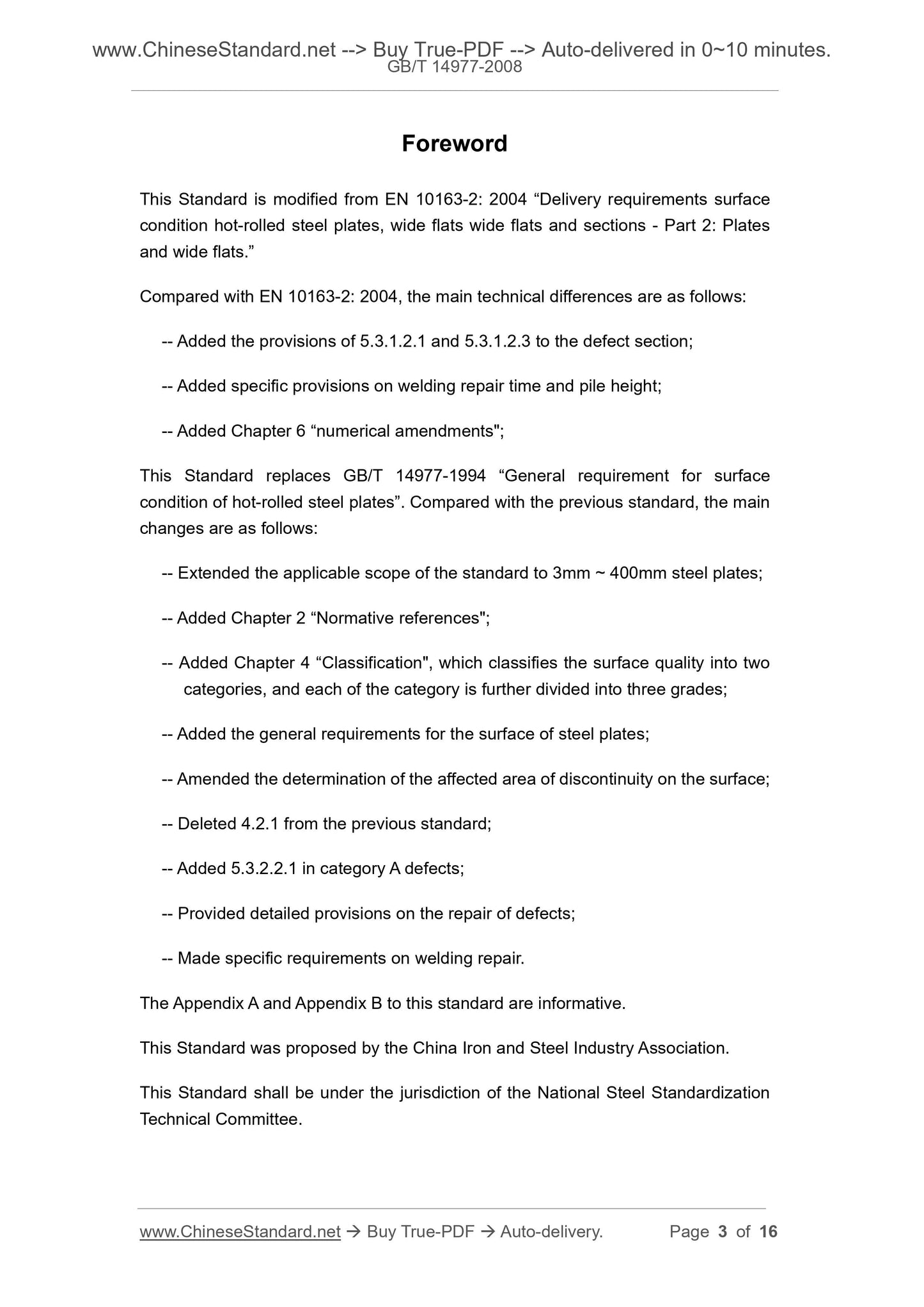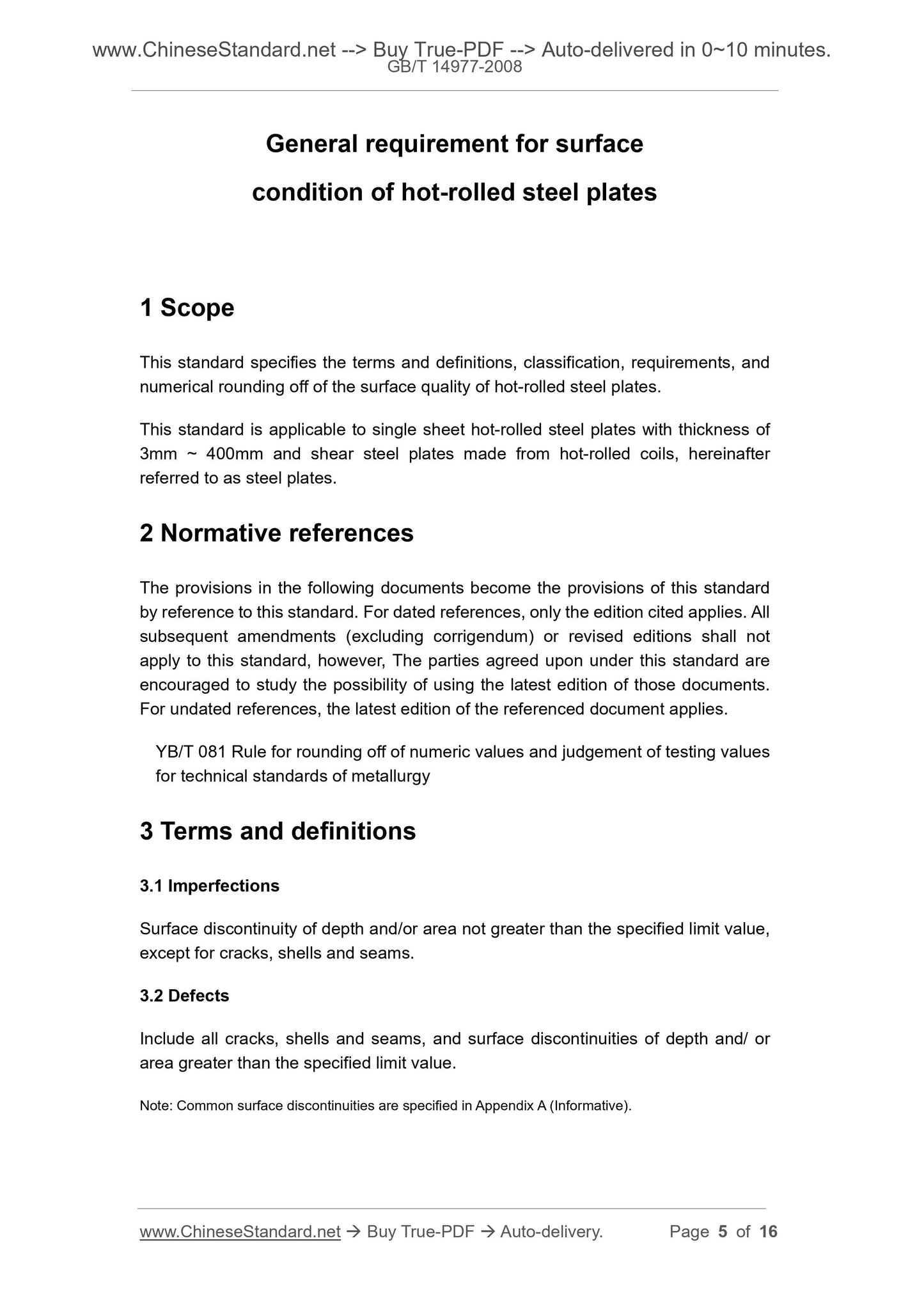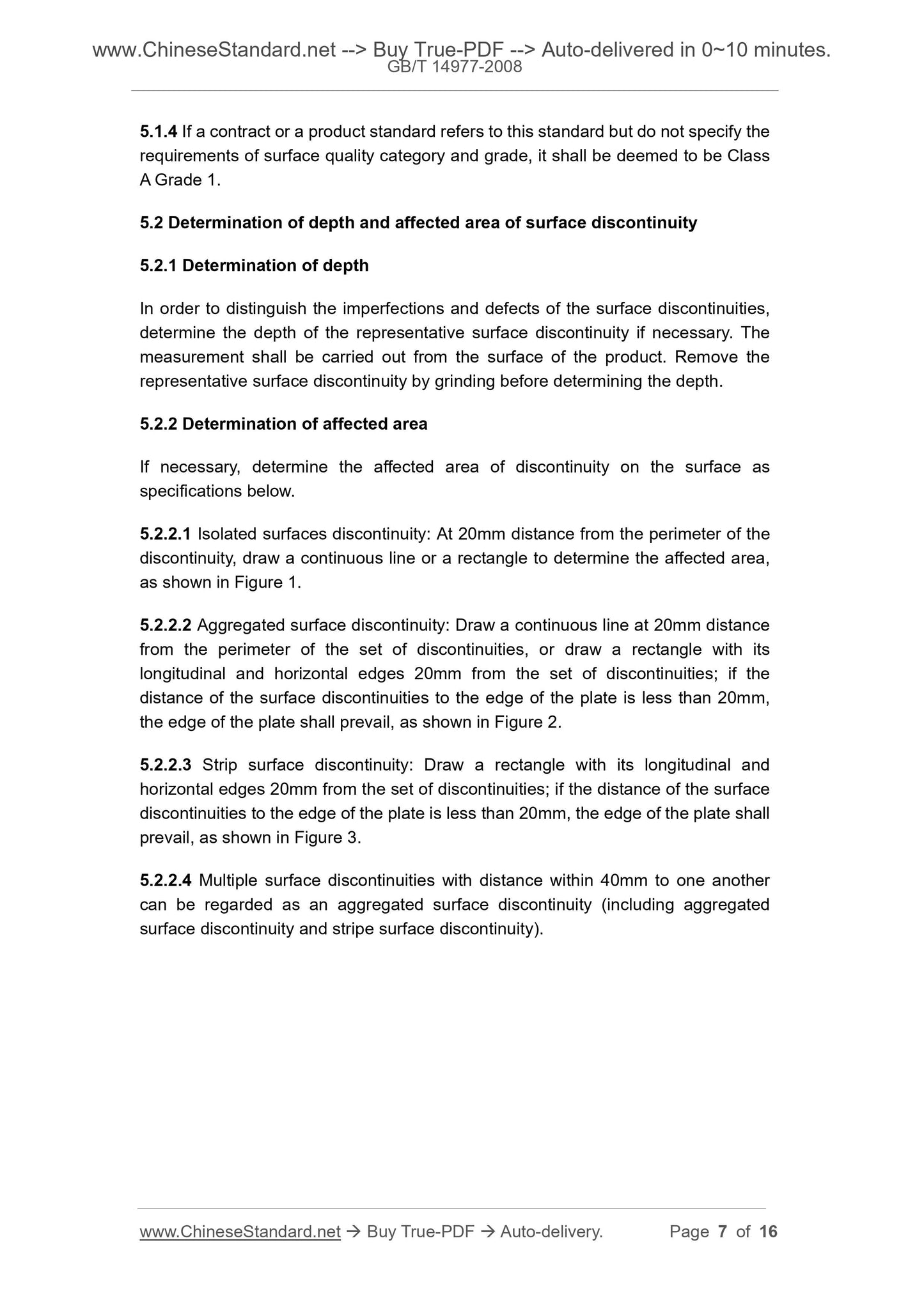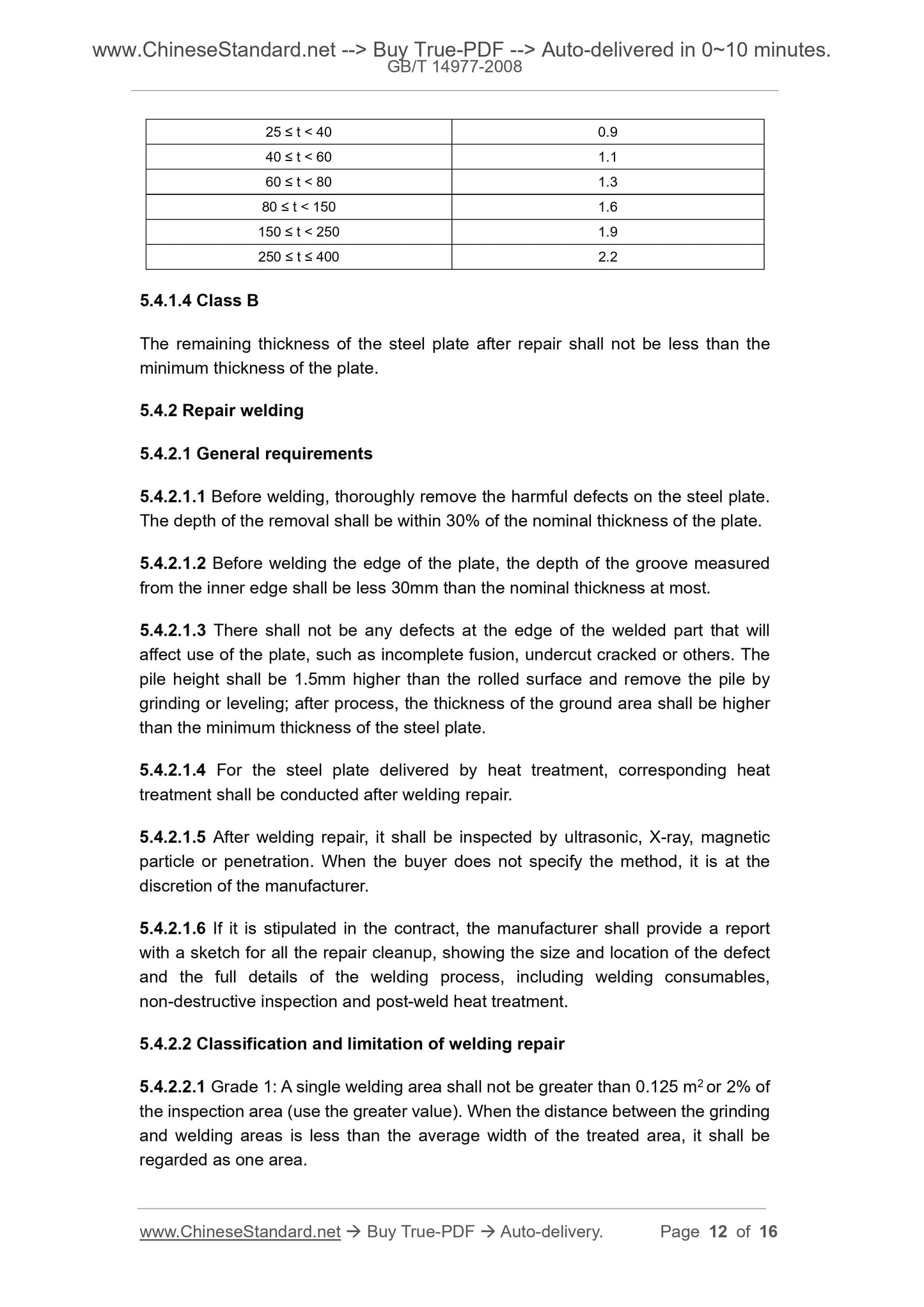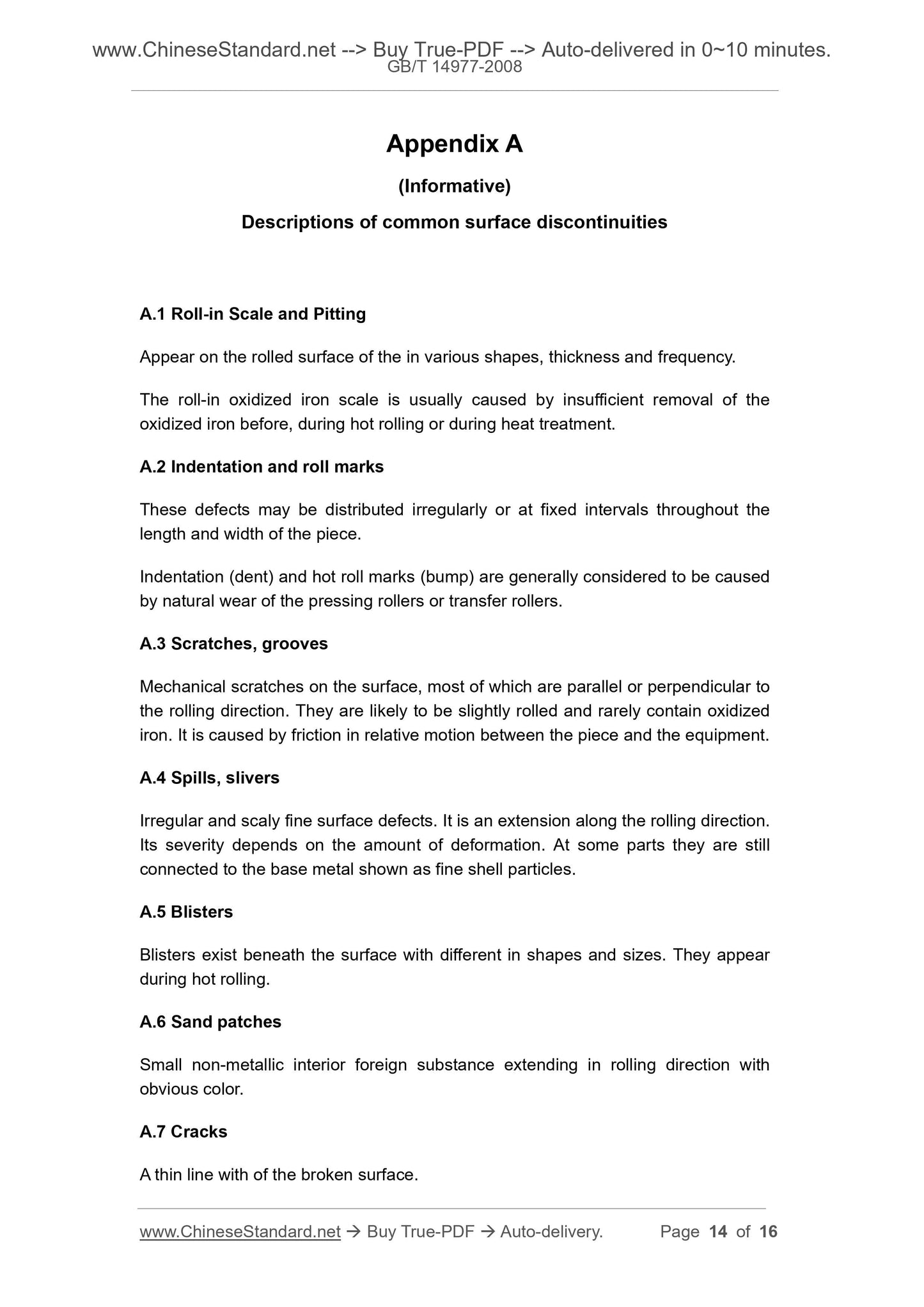1
/
of
7
PayPal, credit cards. Download editable-PDF and invoice in 1 second!
GB/T 14977-2008 English PDF (GBT14977-2008)
GB/T 14977-2008 English PDF (GBT14977-2008)
Regular price
$125.00 USD
Regular price
Sale price
$125.00 USD
Unit price
/
per
Shipping calculated at checkout.
Couldn't load pickup availability
Delivery: 3 seconds. Download true-PDF + Invoice.
Get QUOTATION in 1-minute: Click GB/T 14977-2008
Historical versions: GB/T 14977-2008
Preview True-PDF (Reload/Scroll if blank)
GB/T 14977-2008: General requirement for surface condition of hot-rolled steel plates
GB/T 14977-2008
GB
NATIONAL STANDARD OF THE
PEOPLE’S REPUBLIC OF CHINA
ICS 77.140.50
H 46
Replacing GB/T 14977-1994
General requirement for surface
condition of hot-rolled steel plates
ISSUED ON. DECEMBER 06, 2008
IMPLEMENTED ON. OCTOBER 1, 2009
Issued by. General Administration of Quality Supervision, Inspection
and Quarantine of the People’s Republic of China;
Standardization Administration of the People’s Republic of
China.
Table of Contents
Foreword ... 3
1 Scope ... 5
2 Normative references ... 5
3 Terms and definitions ... 5
4 Classification ... 6
5 Requirements... 6
6 Number rounding off ... 13
Appendix A (Informative) Descriptions of common surface discontinuities . 14
Appendix B (Informative) Classification and requirements of surface quality16
Foreword
This Standard is modified from EN 10163-2.2004 “Delivery requirements surface
condition hot-rolled steel plates, wide flats wide flats and sections - Part 2. Plates
and wide flats.”
Compared with EN 10163-2.2004, the main technical differences are as follows.
-- Added the provisions of 5.3.1.2.1 and 5.3.1.2.3 to the defect section;
-- Added specific provisions on welding repair time and pile height;
-- Added Chapter 6 “numerical amendments";
This Standard replaces GB/T 14977-1994 “General requirement for surface
condition of hot-rolled steel plates”. Compared with the previous standard, the main
changes are as follows.
-- Extended the applicable scope of the standard to 3mm ~ 400mm steel plates;
-- Added Chapter 2 “Normative references";
-- Added Chapter 4 “Classification", which classifies the surface quality into two
categories, and each of the category is further divided into three grades;
-- Added the general requirements for the surface of steel plates;
-- Amended the determination of the affected area of discontinuity on the surface;
-- Deleted 4.2.1 from the previous standard;
-- Added 5.3.2.2.1 in category A defects;
-- Provided detailed provisions on the repair of defects;
-- Made specific requirements on welding repair.
The Appendix A and Appendix B to this standard are informative.
This Standard was proposed by the China Iron and Steel Industry Association.
This Standard shall be under the jurisdiction of the National Steel Standardization
Technical Committee.
General requirement for surface
condition of hot-rolled steel plates
1 Scope
This standard specifies the terms and definitions, classification, requirements, and
numerical rounding off of the surface quality of hot-rolled steel plates.
This standard is applicable to single sheet hot-rolled steel plates with thickness of
3mm ~ 400mm and shear steel plates made from hot-rolled coils, hereinafter
referred to as steel plates.
2 Normative references
The provisions in the following documents become the provisions of this standard
by reference to this standard. For dated references, only the edition cited applies. All
subsequent amendments (excluding corrigendum) or revised editions shall not
apply to this standard, however, The parties agreed upon under this standard are
encouraged to study the possibility of using the latest edition of those documents.
For undated references, the latest edition of the referenced document applies.
YB/T 081 Rule for rounding off of numeric values and judgement of testing values
for technical standards of metallurgy
3 Terms and definitions
3.1 Imperfections
Surface discontinuity of depth and/or area not greater than the specified limit value,
except for cracks, shells and seams.
3.2 Defects
Include all cracks, shells and seams, and surface discontinuities of depth and/ or
area greater than the specified limit value.
Note. Common surface discontinuities are specified in Appendix A (Informative).
5.1.4 If a contract or a product standard refers to this standard but do not specify the
requirements of surface quality category and grade, it shall be deemed to be Class
A Grade 1.
5.2 Determination of depth and affected area of surface discontinuity
5.2.1 Determination of depth
In order to distinguish the imperfections and defects of the surface discontinuities,
determine the depth of the representative surface discontinuity if necessary. The
measurement shall be carried out from the surface of the product. Remove the
representative surface discontinuity by grinding before determining the depth.
5.2.2 Determination of affected area
If necessary, determine the affected area of discontinuity on the surface as
specifications below.
5.2.2.1 Isolated surfaces discontinuity. At 20mm distance from the perimeter of the
discontinuity, draw a continuous line or a rectangle to determine the affected area,
as shown in Figure 1.
5.2.2.2 Aggregated surface discontinuity. Draw a continuous line at 20mm distance
from the perimeter of the set of discontinuities, or draw a rectangle with its
longitudinal and horizontal edges 20mm from the set of discontinuities; if the
distance of the surface discontinuities to the edge of the plate is less than 20mm,
the edge of the plate shall prevail, as shown in Figure 2.
5.2.2.3 Strip surface discontinuity. Draw a rectangle with its longitudinal and
horizontal edges 20mm from the set of discontinuities; if the distance of the surface
discontinuities to the edge of the plate is less than 20mm, the edge of the plate shall
prevail, as shown in Figure 3.
5.2.2.4 Multiple surface discontinuities with distance within 40mm to one another
can be regarded as an aggregated surface discontinuity (including aggregated
surface discontinuity and stripe surface discontinuity).
25 ≤ t < 40 0.9
40 ≤ t < 60 1.1
60 ≤ t < 80 1.3
80 ≤ t < 150 1.6
150 ≤ t < 250 1.9
250 ≤ t ≤ 400 2.2
5.4.1.4 Class B
The remaining thickness of the steel plate after repair shall not be less than the
minimum thickness of the plate.
5.4.2 Repair welding
5.4.2.1 General requirements
5.4.2.1.1 Before welding, thoroughly remove the harmful defects on the steel plate.
The depth of the removal shall be within 30% of the nominal thickness of the plate.
5.4.2.1.2 Before welding the edge of the plate, the depth of the groove measured
from the inner edge shall be less 30mm than the nominal thickness at most.
5.4.2.1.3 There shall not be any defects at the edge of the welded part that will
affect use of the plate, such as incomplete fusion, undercut cracked or others. The
pile height shall be 1.5mm higher than the rolled surface and remove the pile by
grinding or leveling; after process, the thickness of the ground area shall be higher
than the minimum thickness of the steel plate.
5.4.2.1.4 For the steel plate delivered by heat treatment, corresponding heat
treatment shall be conducted after welding repair.
5.4.2.1.5 After welding repair, it shall be inspected by ultrasonic, X-ray, magnetic
particle or penetration. When the buyer does not specify the method, it is at the
discretion of the manufacturer.
5.4.2.1.6 If it is stipulated in the contract, the manufacturer shall provide a report
with a sketch for all the repair cleanup, showing the size and location of the defect
and the full details of the welding process, including welding consumables,
non-destructive inspection and post-weld heat treatment.
5.4.2.2 Classification and limitation of welding repair
5.4.2.2.1 Grade 1. A single welding area shall not be greater than 0.125 m2 or 2% of
the inspection area (use the greater value)....
Get QUOTATION in 1-minute: Click GB/T 14977-2008
Historical versions: GB/T 14977-2008
Preview True-PDF (Reload/Scroll if blank)
GB/T 14977-2008: General requirement for surface condition of hot-rolled steel plates
GB/T 14977-2008
GB
NATIONAL STANDARD OF THE
PEOPLE’S REPUBLIC OF CHINA
ICS 77.140.50
H 46
Replacing GB/T 14977-1994
General requirement for surface
condition of hot-rolled steel plates
ISSUED ON. DECEMBER 06, 2008
IMPLEMENTED ON. OCTOBER 1, 2009
Issued by. General Administration of Quality Supervision, Inspection
and Quarantine of the People’s Republic of China;
Standardization Administration of the People’s Republic of
China.
Table of Contents
Foreword ... 3
1 Scope ... 5
2 Normative references ... 5
3 Terms and definitions ... 5
4 Classification ... 6
5 Requirements... 6
6 Number rounding off ... 13
Appendix A (Informative) Descriptions of common surface discontinuities . 14
Appendix B (Informative) Classification and requirements of surface quality16
Foreword
This Standard is modified from EN 10163-2.2004 “Delivery requirements surface
condition hot-rolled steel plates, wide flats wide flats and sections - Part 2. Plates
and wide flats.”
Compared with EN 10163-2.2004, the main technical differences are as follows.
-- Added the provisions of 5.3.1.2.1 and 5.3.1.2.3 to the defect section;
-- Added specific provisions on welding repair time and pile height;
-- Added Chapter 6 “numerical amendments";
This Standard replaces GB/T 14977-1994 “General requirement for surface
condition of hot-rolled steel plates”. Compared with the previous standard, the main
changes are as follows.
-- Extended the applicable scope of the standard to 3mm ~ 400mm steel plates;
-- Added Chapter 2 “Normative references";
-- Added Chapter 4 “Classification", which classifies the surface quality into two
categories, and each of the category is further divided into three grades;
-- Added the general requirements for the surface of steel plates;
-- Amended the determination of the affected area of discontinuity on the surface;
-- Deleted 4.2.1 from the previous standard;
-- Added 5.3.2.2.1 in category A defects;
-- Provided detailed provisions on the repair of defects;
-- Made specific requirements on welding repair.
The Appendix A and Appendix B to this standard are informative.
This Standard was proposed by the China Iron and Steel Industry Association.
This Standard shall be under the jurisdiction of the National Steel Standardization
Technical Committee.
General requirement for surface
condition of hot-rolled steel plates
1 Scope
This standard specifies the terms and definitions, classification, requirements, and
numerical rounding off of the surface quality of hot-rolled steel plates.
This standard is applicable to single sheet hot-rolled steel plates with thickness of
3mm ~ 400mm and shear steel plates made from hot-rolled coils, hereinafter
referred to as steel plates.
2 Normative references
The provisions in the following documents become the provisions of this standard
by reference to this standard. For dated references, only the edition cited applies. All
subsequent amendments (excluding corrigendum) or revised editions shall not
apply to this standard, however, The parties agreed upon under this standard are
encouraged to study the possibility of using the latest edition of those documents.
For undated references, the latest edition of the referenced document applies.
YB/T 081 Rule for rounding off of numeric values and judgement of testing values
for technical standards of metallurgy
3 Terms and definitions
3.1 Imperfections
Surface discontinuity of depth and/or area not greater than the specified limit value,
except for cracks, shells and seams.
3.2 Defects
Include all cracks, shells and seams, and surface discontinuities of depth and/ or
area greater than the specified limit value.
Note. Common surface discontinuities are specified in Appendix A (Informative).
5.1.4 If a contract or a product standard refers to this standard but do not specify the
requirements of surface quality category and grade, it shall be deemed to be Class
A Grade 1.
5.2 Determination of depth and affected area of surface discontinuity
5.2.1 Determination of depth
In order to distinguish the imperfections and defects of the surface discontinuities,
determine the depth of the representative surface discontinuity if necessary. The
measurement shall be carried out from the surface of the product. Remove the
representative surface discontinuity by grinding before determining the depth.
5.2.2 Determination of affected area
If necessary, determine the affected area of discontinuity on the surface as
specifications below.
5.2.2.1 Isolated surfaces discontinuity. At 20mm distance from the perimeter of the
discontinuity, draw a continuous line or a rectangle to determine the affected area,
as shown in Figure 1.
5.2.2.2 Aggregated surface discontinuity. Draw a continuous line at 20mm distance
from the perimeter of the set of discontinuities, or draw a rectangle with its
longitudinal and horizontal edges 20mm from the set of discontinuities; if the
distance of the surface discontinuities to the edge of the plate is less than 20mm,
the edge of the plate shall prevail, as shown in Figure 2.
5.2.2.3 Strip surface discontinuity. Draw a rectangle with its longitudinal and
horizontal edges 20mm from the set of discontinuities; if the distance of the surface
discontinuities to the edge of the plate is less than 20mm, the edge of the plate shall
prevail, as shown in Figure 3.
5.2.2.4 Multiple surface discontinuities with distance within 40mm to one another
can be regarded as an aggregated surface discontinuity (including aggregated
surface discontinuity and stripe surface discontinuity).
25 ≤ t < 40 0.9
40 ≤ t < 60 1.1
60 ≤ t < 80 1.3
80 ≤ t < 150 1.6
150 ≤ t < 250 1.9
250 ≤ t ≤ 400 2.2
5.4.1.4 Class B
The remaining thickness of the steel plate after repair shall not be less than the
minimum thickness of the plate.
5.4.2 Repair welding
5.4.2.1 General requirements
5.4.2.1.1 Before welding, thoroughly remove the harmful defects on the steel plate.
The depth of the removal shall be within 30% of the nominal thickness of the plate.
5.4.2.1.2 Before welding the edge of the plate, the depth of the groove measured
from the inner edge shall be less 30mm than the nominal thickness at most.
5.4.2.1.3 There shall not be any defects at the edge of the welded part that will
affect use of the plate, such as incomplete fusion, undercut cracked or others. The
pile height shall be 1.5mm higher than the rolled surface and remove the pile by
grinding or leveling; after process, the thickness of the ground area shall be higher
than the minimum thickness of the steel plate.
5.4.2.1.4 For the steel plate delivered by heat treatment, corresponding heat
treatment shall be conducted after welding repair.
5.4.2.1.5 After welding repair, it shall be inspected by ultrasonic, X-ray, magnetic
particle or penetration. When the buyer does not specify the method, it is at the
discretion of the manufacturer.
5.4.2.1.6 If it is stipulated in the contract, the manufacturer shall provide a report
with a sketch for all the repair cleanup, showing the size and location of the defect
and the full details of the welding process, including welding consumables,
non-destructive inspection and post-weld heat treatment.
5.4.2.2 Classification and limitation of welding repair
5.4.2.2.1 Grade 1. A single welding area shall not be greater than 0.125 m2 or 2% of
the inspection area (use the greater value)....
Share
